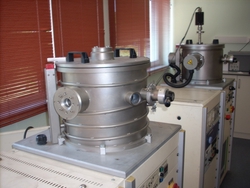Thin Film Coating Systems
RF-PECVD (Radio Frequency Plasma-Enhanced Chemical Vapor Deposition)
 Reactive DC Magnetron Sputtering / Plasma-Enhanced Chemical Vapor Deposition (PECVD) Thin Film Coating System HEF TSD-350 PECVD
Reactive DC Magnetron Sputtering / Plasma-Enhanced Chemical Vapor Deposition (PECVD) Thin Film Coating System HEF TSD-350 PECVD
Technical
The sputtering process involves the removal of surface atoms of a target material by ionized gas atoms (usually a neutral gas), their expulsion, and the deposition of these expelled atoms onto the base material intended to be coated with a thin layer. PECVD, on the other hand, is a method that allows for the deposition of thin layers through chemical reactions occurring in a plasma environment as a result of electrical discharge using a precursor gas. With the coating system available in our center, it is possible to perform these two techniques, which involve low-temperature processes, within the same vacuum chamber. In addition to the precursor argon gas, reactive gases such as oxygen and acetylene can be used in the system. The applied current is DC, and ionization within the system is increased through a magnet design behind the target material. The shield system present in front of the target material enables operation in both PVD and PECVD modes, allowing coating on a wide range of materials.
Equipment Specifications
- Ability to work in both PVD and PECVD modes
- High repeatability due to reliable control of process parameters
- Easy modification of important process parameters (distance between target and base material, bias voltage, sputtering power, etc.) for the development of new coating types
- DC power supply (2500 W)
- Precise temperature control thanks to external heating system
- Ability to operate at vacuum levels of 10-7 mbar using rotary and turbomolecular pumps
- RF Magnetron Sputtering Thin Film Coating System HEF TSD-350 CMRF
RF Sputtering Technique
Having the applied current in the coating process be RF ensures that the charge on the cathode surface alternates (+,-) at a frequency of 13.56 MHz, thus preventing the charge problem in insulating materials. Despite having lower coating speeds compared to DC magnetron sputtering, the advantage of being able to sputter insulating cathodes has positioned RF magnetron sputtering as an important technique among thin film coating methods.
Equipment Specifications
- RF power supply
-
Ability to work with both insulating and conductive materials
-
High repeatability due to reliable control of process parameters
-
Easy modification of important process parameters (distance between target and base material, bias voltage, sputtering power, etc.) for the development of new coating types
-
Precise temperature control thanks to external heating system
Applications
-
Tribological Coatings: Coating surfaces of machine parts such as cutting tools used in metal cutting and processing, molds used in metal forming, and gears with wear-resistant materials such as TiN, TiCN, B4C, diamond-like carbon-DLC, etc., is a widely used solution.
-
Optical Coatings: Coating material surfaces with materials such as SiO2, TiO2, etc., which change optical properties such as reflectivity, refractive index, absorption.
-
Microelectronic Applications: Thin films have various uses in microelectronic applications, such as electrically insulating layers, very thin dielectrics in MOS transistors. Piezo and ferroelectric compounds such as LiNbO3, PLZT are used as thin films in integrated form with semiconductor silicon technology in electro-optical, memory, sensor applications.
-
Solar Cell Applications: Polycrystalline compounds such as CuO, Cu(In,Ga)Se2 find their place in solar cell applications in thin film form.